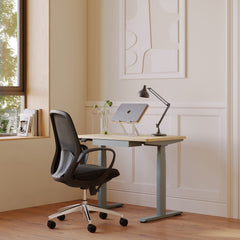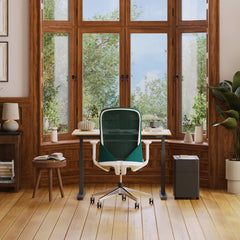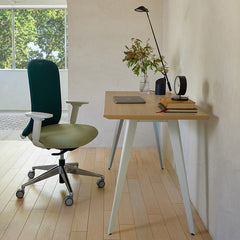Get 10% off your first order
Find the office furniture that’s designed to match your style, comfort, and needs perfectly. Subscribe
Space Shift: The Art of the Live-Work Fusion

Visit quiz page to see how we makes it easy to create an inspiring workplace


Clutter persists because most desks were never designed to route power for multiple devices. Laptops, external displays, webcams, headsets, phones, and desk lamps all compete for outlets and space. The result is a constantly shifting tangle of cords and adapters that slows setup, distracts the eye, and complicates even simple tasks like docking a laptop. When power and data paths are integrated into the workstation itself, cables move out of sight and friction disappears from daily workflows. Design-forward systems such as Urbanica office desk designs show how structure, not accessories, delivers a consistently clean surface.
Visual noise pulls focus and increases cognitive load. Every time a charger slips off the desk or a cable crosses the mouse path, the brain allocates attention to a small fix instead of the task at hand. Clean routing prevents these micro-interruptions and protects momentum. Order on the surface signals order in the work.
Unmanaged cords create snag risks, stress connectors, and can block ventilation around docks or power bricks. Properly sized channels and trays keep high-draw adapters away from paper stacks and fabric while maintaining airflow.
A power-integrated desk does more than add outlets. It aligns device placement, reach zones, and sightlines with a cable architecture that lives below or behind the working plane. The goal is a surface that stays visually open while every essential port remains within comfortable reach.
Recessed AC sockets, USB-C power delivery, and grommets placed near typical device zones let users connect without dragging cables across the desktop. When access points are predictable and symmetrical, teams can share spaces without creating cord clutter.
Collaborative layouts benefit from centrally planned distribution. A balanced example is the Quad Workstation for collaborative teams, which brings power to the center where devices gather and routes cords downward in an orderly path. Every seat gains equal access, and the shared surface stays clear for real work.
Different devices require different power profiles. Selecting the right mix prevents add-on strips and dongles from returning to the surface.
| Access format | Best use case | Primary benefit | Typical placement |
|---|---|---|---|
| AC outlets | Monitors and docks | Reliable high-draw power | Recessed below surface or in a modesty channel |
| USB-C PD | Laptops and tablets | Single-cable charge and data | Surface module or edge-mounted hub |
| USB-A | Legacy peripherals | Backward compatibility | Underside hub or grommet insert |
| Qi wireless pad | Phones and earbuds | Grab-and-go charging | Inset at the front corner, flush to surface |
Keep high-draw adapters and docks below the desk, place phone charging near the dominant hand, and position display cables at the rear center. This simple zoning keeps cable paths short and predictable.
Power integration succeeds only when cable routing is deliberate and concealed. Horizontal and vertical pathways must work together so cords never spill into the leg space or across the desktop.
The most effective approach is a continuous tray that collects bricks, power bars, and excess cable length. A well-sized shelf also improves serviceability, since everything is accessible without crawling under the desk. A system like a concealed under-desk cable tray keeps adapters restrained and off the floor, which helps with airflow and cleaning.
| Routing method | Visibility | Reconfiguration effort | Ideal scenario |
|---|---|---|---|
| Under-desk tray | Hidden from seated view | Easy to adjust | Multi-device individual desks |
| Panel-integrated channel | Fully concealed | Planned changes | Long-term benching runs |
| Vertical cable spine | Minimal visual footprint | Simple to reroute | Height-adjustable and shared stations |
Floor-to-desk travel is where clutter often reappears. A flexible cable spine for floor-to-desk routing guides conductors neatly and moves with sit-stand adjustments. It prevents cords from dragging and reduces snag risk for rolling chairs or vacuum equipment.
Mark every outlet, switch, and device on a floor plan before installation. Shorter paths produce fewer visible segments and reduce the amount of cable to manage. Label both ends of every run to simplify later changes.
Partitions do more than divide space. When designed with cable channels and pass-through points, panels become the backbone of a clean power strategy.
Well-built partitions provide concealed pathways from floor feeds to desktop entry points. That structure eliminates the need for floor strips and reduces the number of visible grommets. For open offices that still value quiet focus, acoustic privacy panels with cable channels deliver visual simplicity and a more comfortable sound profile.
When every bay follows the same routing pattern, a bench looks intentional and remains easy to service. Technicians know where to find slack and connection points without lifting every worksurface.
Built-in power should handle most needs, yet some users benefit from a movable access point that keeps pace with changing setups.
A compact edge device, such as a USB-C clamp power module, adds ports where they are most convenient without drilling the desk. The clamp form factor holds steady, keeps cables short, and can be repositioned in seconds.
When a lamp, monitor arm, and hub share concealed routing, the desk remains visually calm. Place the lamp’s cord into the same grommet as the display cable, and coil excess length inside the tray. One smooth curve to the surface is all the eye should see.
Ergonomic comfort improves when devices can be positioned precisely without cable constraints.
Screen height determines neck angle, and keyboard placement shapes wrist position. Clean routing allows optimal placement without pulling on connectors. Reference frameworks from NIOSH ergonomics guidance reinforce that neutral joint angles and reduced repetition are central to sustained comfort.
Integrated outlets reduce the need to bend under the desk to plug and unplug devices. Over time, fewer awkward reach motions help lower fatigue and discomfort.
Reducing disposable accessories and over-specified power bars is a practical way to cut waste while improving reliability.
When power is integrated into the furniture, users rely on fewer plastic adapters and off-the-shelf strips that fail or become obsolete. Cables are protected from abrasion and kinking, which extends their usable life.
Shorter cable runs and organized junction points simplify power-down routines. Users can place essential devices on one controlled circuit and nonessential accessories on another, making it easy to shut off idle loads at the end of the day.
Different spaces call for different workstation patterns. Select the architecture that fits the culture of work rather than forcing a one-size approach.
A single user with two displays and a laptop benefits from a centered monitor mount, rear grommets, and a full-length tray. The phone charging pad sits on the dominant-hand side, and the dock lives in the tray with a short USB-C cable to the laptop.
Two seats can share a central cable channel and symmetrical access points. A short, labeled patch panel collects both users’ display cables and routes them to their PCs, leaving no extra length on the surface.
For a six-seat pod, equal access to power keeps people from trading outlets mid-day. A solution like a six-user workstation with integrated power spreads distribution evenly and routes cords vertically in predictable intervals so the overall look stays ordered.
A clean install pays off every day. Follow a stepwise plan and document choices so future changes do not undo the work.
1. Identify all powered devices and data connections for each seat.
2. Place panels, then route primary feeds to concealed channels.
3. Mount the tray, confirm capacity for bricks and hubs, and add tie points.
4. Route vertical drops with spines or panel pass-throughs.
5. Label both ends of each cable.
6. Coil and secure slack in the tray, not on the floor.
7. Set final device positions on the surface and trim lengths for a single smooth arc into the grommet.
A simple label map prevents guesswork when equipment changes. Clear documentation also shortens service calls and reduces accidental unplugging.
A well-designed system should be easy to refresh. Small habits protect the clean look for years.
Inspect strain relief at grommets, confirm tray fasteners are tight, remove dust buildup around bricks, and resecure any Velcro ties that have loosened. Replace worn cable ties with soft, reusable straps to avoid pinching.
When a laptop or dock changes, replace only the necessary cable runs. This incremental approach keeps the system flexible without unraveling the entire path.
Even strong setups can run into small issues. Solve them quickly with targeted checks.
Add a shallow divider or a simple strap at the tray edge so bricks cannot creep outward. Confirm the tray sits close enough to the rear beam to prevent gaps.
Shorten the surface-to-grommet lengths and secure the first 10 centimeters below the desk with an adhesive-backed clip. This hides the final segment without stressing connectors.
Balance plugs across circuits and keep high-draw monitors and docks separate from charging hubs. If heat builds in the tray, add small spacers under bricks to increase airflow.
Networking lines also affect how tidy a desk looks. Good policies protect appearance and performance.
Keep power and Ethernet in parallel paths with enough spacing to reduce interference. Cross at right angles when they must intersect and avoid coiling data cables tightly.
Short, labeled patch cables reduce loops around the rear of displays. Keep the switch or router off the desk surface and mounted inside the panel or tray zone when appropriate.
Modern work surfaces look better when technical elements are quiet and color choices support the architecture.
Match cable jackets and spines to leg finishes or panel colors. A cable that blends with the frame is far less noticeable than an all-purpose black cord in a light room. Choose matte finishes that do not reflect under task lighting.
Clean oval or circular grommets with low-profile surrounds feel intentional. Position them symmetrically so the desk face looks balanced even when nothing is plugged in.
People who move between home and office benefit from predictable connections that do not spill across the desk.
Place a dock in the tray and run one short USB-C cable to the laptop position. Displays, audio, and Ethernet live below the surface. This keeps the daily connect and disconnect simple and preserves a clean look.
Keep a shallow bin in the tray for occasional-use items like card readers. The accessory leaves the desk as soon as the task ends, which protects the visual calm of the worktop.
Examples help translate principles into layouts that any team can adopt.
Route both display power cords into the tray, connect the camera and task light through a small hub mounted under the rear edge, and power the hub from the tray. Only the light’s on-cord switch remains visible, positioned neatly at arm’s reach.
Mount the monitor arm to open desk space. Run power through the rear grommet, and coil the surplus length in the tray. A single surface cable arcs to the laptop. Phone charging lives in a front corner with an inset pad.
The future of built-in power desks lies in balancing human comfort with spatial intelligence. As offices evolve into hybrid ecosystems, workstations must adapt to diverse body types, cultural preferences, and spatial layouts. A well-integrated desk does more than provide electricity; it shapes posture, movement, and flow throughout the day. Human-centered design focuses on how the furniture interacts with real people, ensuring technology enhances rather than dominates the workspace.
Office design trends differ across regions. In dense urban environments, floor space is at a premium, making compact, multi-user power desks essential. Open layouts in North American and European offices prioritize collaboration and visibility, while in Asia-Pacific, partitioned modular systems often emphasize focus and privacy. By integrating built-in power within these cultural and spatial preferences, companies can localize functionality without sacrificing visual harmony. This geographic adaptation creates a seamless balance between aesthetic and practical needs.
Workplace design is becoming data-informed. AI-driven layout tools now simulate user movement, ergonomic reach, and light exposure to recommend optimal desk placement. These insights help architects determine where integrated power channels and vertical routing should go before construction begins. Smart design engines can map plug distribution, predict user congestion points, and align ergonomic guidelines with energy efficiency. When combined with human insight, these tools ensure that every workstation supports both comfort and productivity.
Clutter-free surfaces improve how teams communicate and share ideas. With power integration keeping devices organized, video calls, digital whiteboards, and shared monitors function without distraction. Cables no longer cross shared spaces or block visibility. This clarity benefits hybrid teams who move fluidly between in-person and remote collaboration. Built-in power thus becomes the invisible infrastructure that supports a cohesive digital culture.
As businesses continue to redefine the purpose of the office, flexibility will remain central. Desks that integrate power elegantly allow workspaces to evolve without renovation. When layout changes are needed, modular cable systems and adaptable routing make it simple to reconfigure seating, scale teams, or add new technology without breaking the visual rhythm of the environment. This adaptability ensures longevity and reduces waste, aligning workplace design with environmental and economic sustainability.

Space Shift: The Art of the Live-Work Fusion

How to Arrange Furniture to Maximize Peace

Crafting Calm: Your Guide to the Perfect Reading Corner
Get 10% off your first order
Find the office furniture that’s designed to match your style, comfort, and needs perfectly. Subscribe
Leave a comment